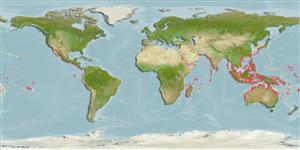>
Anguilliformes (Eels and morays) >
Ophichthidae (Snake eels) > Ophichthinae
Etymology: Pisodonophis: Greek, piso, pipisko = to drink + Greek, odous = teeth + Greek, ophis = serpent.
More on author: Richardson.
Environment: milieu / climate zone / kisaran kedalaman / distribution range
Ekologi
laut; air tawar; payau berasosiasi dengan karang; anadromus (ruaya dari laut ke air tawar) (Ref. 51243); kisaran kedalaman 1 - 20 m (Ref. 90102). Tropical
Indo-Pacific: Red Sea and East Africa to French Polynesia, north to the Ogasawara Islands, south to Australia.
Size / Weight / umur
Kematangan: Lm ? range ? - ? cm
Max length : 108 cm TL jantan/; (Ref. 1479); common length : 50.0 cm TL jantan/; (Ref. 7245)
deskripsi pendek
Kunci identifiaksi (pengenalan) | Morfologi | Morfometrik
Duri punggung (Keseluruhan (total)) : 0; Duri dubur: 0; vertebrata, bertulang belakang: 152 - 163. Teeth molariform, multiserial on jaws, intermaxillary and vomer; dorsal fin with broad dark edge (Ref. 37816). Dorsal fin beginning above pectoral fin (Ref. 12693). Body snake-like, cylindrical, compressed only along extreme tail tip; anterior nostril tubular, posterior nostril along lower edge of lip; median fins not continuous posteriorly; extreme tip of tail stiff and finless; dorsal fin origin over front to middle portion of pectoral fins; lateral line inconspicuous (Ref. 4832). Variable from grey to black or brown. Large individuals have wrinkled skin (Ref. 48635).
Body shape (shape guide): eel-like; Cross section: circular.
Occurs in lagoons and estuaries, entering freshwater (Ref. 12693). Often in tidal channels where loose groups congregate, and usually seen with just the head exposed (Ref. 48635). Caught most often in tidal areas and estuaries (Ref. 12693). Caught in bag nets and similar gear. Marketed fresh (Ref. 7050).
Life cycle and mating behavior
Kematangan | Reproduksi, perkembang biakan | Pemijahan | telur-telur | Fecundity | Larva
McCosker, J.E. and P.H.J. Castle, 1986. Ophichthidae. p. 176-186. In M.M. Smith and P.C. Heemstra (eds.) Smiths' sea fishes. Springer-Verlag, Berlin. (Ref. 3972)
Status IUCN Red List (Ref. 130435: Version 2025-1)
ancaman kepada manusia
Harmless
penggunaan manusia
Perikanan: nilai komersial kecil
Alat, peralatan
laporan khas
muat turun XML
Sumber internet
Estimates based on models
Preferred temperature (Acuan
123201): 24.2 - 29.3, mean 28.4 °C (based on 3721 cells).
Phylogenetic diversity index (Acuan
82804): PD
50 = 0.5039 [Uniqueness, from 0.5 = low to 2.0 = high].
Bayesian length-weight: a=0.00063 (0.00033 - 0.00121), b=3.01 (2.84 - 3.18), in cm total length, based on LWR estimates for this species & (Sub)family-body (Ref.
93245).
Trophic level (Acuan
69278): 3.8 ±0.6 se; based on size and trophs of closest relatives
Daya lenting (Acuan
120179): sedang, Waktu penggandaan populasi minimum 1.4 - 4.4 tahun (Preliminary K or Fecundity.).
Fishing Vulnerability (Ref.
59153): High vulnerability (65 of 100).
🛈
Nutrients (Ref.
124155): Calcium = 30.8 [17.2, 57.1] mg/100g; Iron = 0.457 [0.272, 0.847] mg/100g; Protein = 19.1 [16.9, 21.7] %; Omega3 = 0.101 [0.046, 0.277] g/100g; Selenium = 38.2 [21.5, 73.7] μg/100g; VitaminA = 42.4 [12.8, 137.4] μg/100g; Zinc = 1.05 [0.75, 1.48] mg/100g (wet weight);
